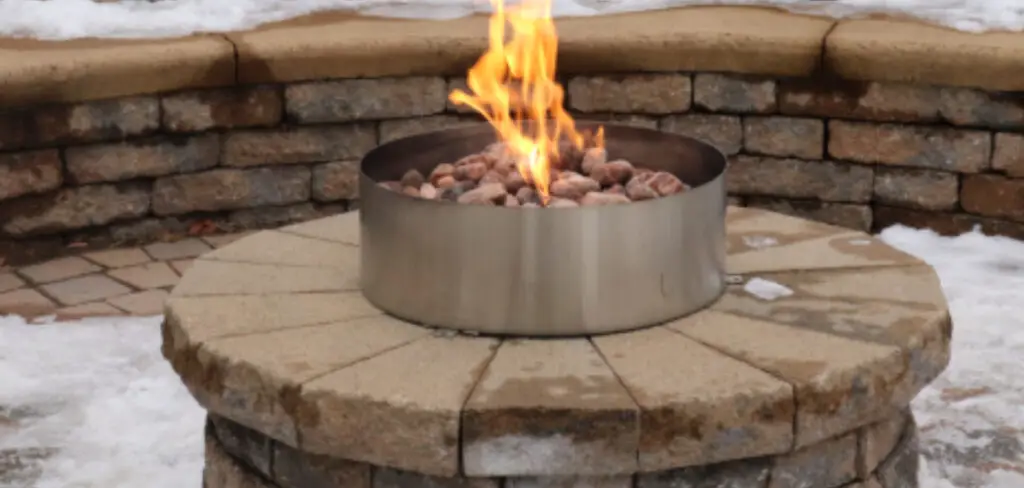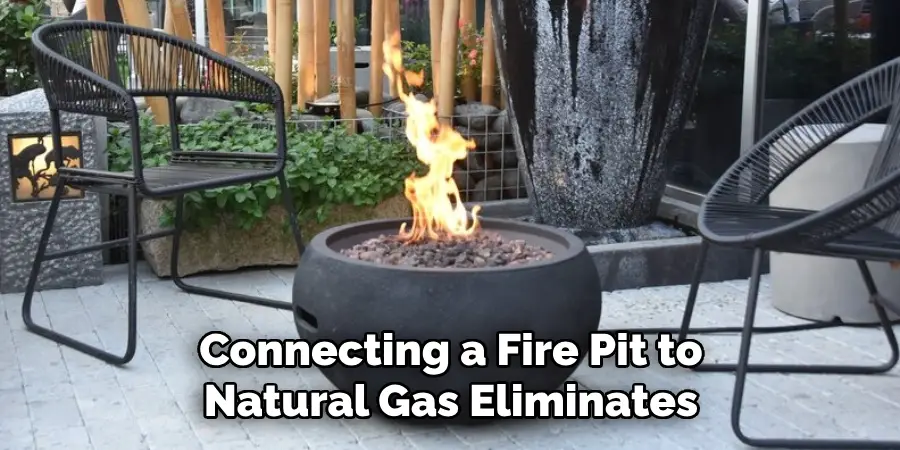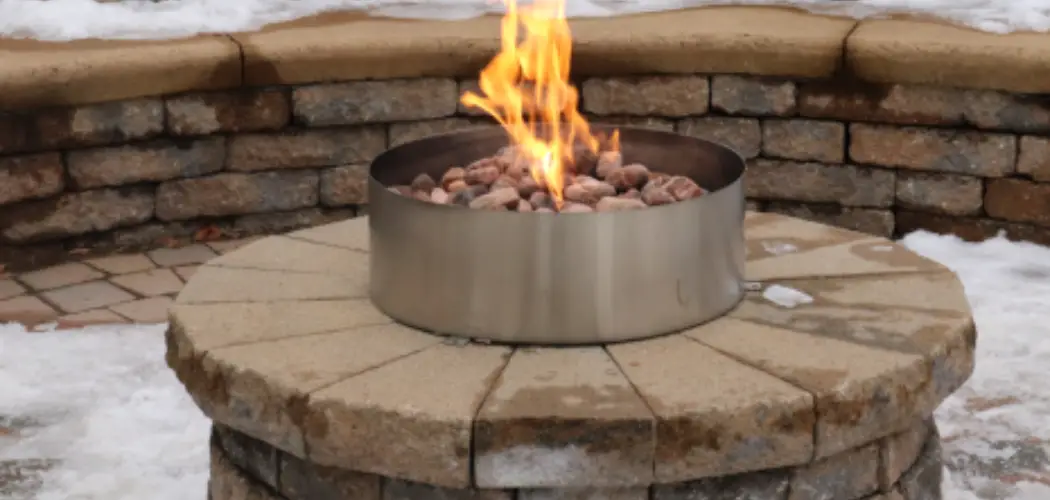Nothing beats the ambiance of a fire pit, especially on chilly evenings. However, the constant need for firewood and the hassle of cleaning ash can be tiresome. But did you know that you can connect your fire pit to natural gas? This saves you money and reduces the work you’d have to put in. In this blog, we’ll take you through the steps on how to connect fire pit to natural gas.

Can You Connect the Fire Pit to Natural Gas?
If you’re looking for a convenient and eco-friendly way to enjoy your backyard fire pit, connecting it to natural gas may be the way to go. Not only does natural gas burn cleaner than traditional wood fires, but it also eliminates the need for storing and hauling heavy propane tanks.
But before you start digging trenches and calling your local utility company, consider a few things. A professional installer should assess your fire pit to ensure it’s compatible with conversion to natural gas.
Additionally, permits and building codes may vary depending on your location, so it’s important to do your research beforehand. With proper planning and execution, you can easily enjoy the warmth and ambiance of your fire pit with the added benefits of clean-burning natural gas.
Why Should You Connect Fire Pit to Natural Gas?
Have you ever been enjoying a warm, cozy fire, only to suddenly die out due to a lack of propane or firewood? Connecting your fire pit to natural gas eliminates this issue and provides a more convenient and reliable fuel source.
Not only will you no longer have to worry about running out of propane mid-roast, but connecting to natural gas also saves you money in the long run compared to constantly buying propane or firewood.

Additionally, natural gas burns more cleanly than wood, reducing air pollution and creating a safer environment for your family and friends. So why not make the switch and enjoy hassle-free fires for years to come?
7 Steps to Follow on How to Connect Fire Pit to Natural Gas
Step 1: Shut off the Gas Supply
The first step in connecting a fire pit to natural gas is to shut off the gas supply. This is done by turning the main valve on the gas line off. If there are any other valves in the line, they should also be closed before proceeding. Once all of the valves are closed, you can begin to connect your fire pit to the natural gas line.
Step 2: Install a Gas Shutoff Valve
Before connecting your fire pit to natural gas, you must install a gas shutoff valve between the main valve and your fire pit. This will allow you to easily turn off the gas flow if needed, such as when cleaning or performing maintenance on your fire pit.
Step 3: Connect Flexible Hose
After installing a shutoff valve, you must connect a flexible hose to your fire pit’s burner assembly. Make sure that all connections are tight and secure before proceeding further. If using a gas log set, install the appropriate adapter before connecting the flexible hose.

Step 4: Test for Leaks
Once all of the connections have been made, it is important to test for leaks by using soapy water and a brush or spray bottle. If bubbles appear around any of the connections, this indicates that there is a leak present, and it must be fixed before continuing with the installation.
Step 5: Turn on the Gas Supply
After ensuring that no leaks are present in your connection, you can turn on the main valve on the gas line and slowly open up each individual shutoff valve until you reach full pressure at your fire pit’s burner assembly. Be sure to monitor the pressure gauge at all times and adjust the shutoff valves accordingly.
Step 6: Light Pilot
Once you have reached full pressure, you can light the pilot light in your fire pit’s burner assembly. Depending on the type of fire pit you have, this process may vary, so consult your owner’s manual for instructions if needed.
Step 7: Perform Final Checks
Before using your fire pit, it is important to perform a few final checks to ensure that everything is working properly. Check the pilot light flame and make sure that it is burning steadily.
Also, check the pressure gauge to make sure that the pressure is at an appropriate level. Once all of these checks have been completed and you are satisfied with the results, your fire pit is ready for use!

5 Considerations Things When You Need to Connect Fire Pit to Natural Gas
1. Check Local Regulations
Before you start connecting your fire pit to natural gas, it is important to check with your local building codes and regulations to ensure that you comply. You may need permits or other documents to connect a gas line to your fire pit, so check with the local authorities before beginning. Additionally, be aware of any safety regulations related to connecting a gas line, as these can vary from state to state.
2. Hire a Professional
If you are not experienced in plumbing and gas work, it is best to hire a professional plumber or contractor familiar with connecting a fire pit to natural gas. This will help ensure that the job is done correctly and safely and provide peace of mind knowing that the job has been done by someone who knows what they are doing.
3. Choose the Right Gas Line
When choosing the right gas line for your fire pit, it is important to consider the size and length of the line needed for your specific project. The line size will depend on how much natural gas you plan on using for your fire pit and how long it needs to run from the source of natural gas to your fire pit. Be sure to choose a line that can handle your project’s volume and pressure requirements.
4. Select an Appropriate Natural Gas Source
Once you have determined what type of natural gas source is required for your project, it is important that you select one that meets all safety requirements and regulations set forth by local authorities.
Natural gas sources can include home tanks, propane tanks, or city-supplied lines; each option has its own pros and cons, so make sure you research them thoroughly before making a decision.
5. Install Proper Ventilation
When connecting a fire pit to natural gas, proper ventilation must be installed to ensure the safe operation of the appliance. This includes installing vents near appliances such as stoves or ovens where exhaust fumes could collect if ventilation isn’t present; this helps prevent the build-up of potentially hazardous gases inside your home or business premises which could lead to health risks if left unchecked.
Additionally, vents should be installed near windows or doors for fresh air circulation within enclosed areas where combustion occurs due to burning fuel sources such as wood or coal used in fire pits powered by natural gas lines.
5 Benefits of Connect Fire Pit to Natural Gas
1. Endless Heat Source
Connecting a fire pit to natural gas eliminates the need for propane tanks and charcoal, providing an endless heat source that can be used year-round. Natural gas is also more cost-effective than other fuel sources, making it a great option for those saving on outdoor heating.

2. Convenience
Connecting a fire pit to natural gas is incredibly convenient as it eliminates the need to constantly refuel the fire pit with propane or charcoal. Additionally, there are no messy ashes or smoke to clean up after each use.
3. Safety
Natural gas is one of the safest fuel sources available for outdoor fire pits as it is non-toxic and produces no dangerous fumes or emissions. Additionally, natural gas fire pits are equipped with safety features such as automatic shut-off valves that will turn off the flame if it detects a leak in the system.
4. Environmentally Friendly
Natural gas is one of the most environmentally friendly fuel sources, producing fewer carbon emissions than other fuels such as wood, charcoal, and propane. This makes natural gas ideal for those looking to reduce their carbon footprint while still enjoying an outdoor fire pit experience.
5. Versatility
Connecting a fire pit to natural gas allows users to easily switch between different flame heights and colors depending on their preferences and moods. This versatility ensures that users can enjoy their outdoor space regardless of weather conditions or time of day.
Conclusion
Connecting your fire pit to natural gas is a smart choice for anyone looking to enjoy the warm glow of a fire without the hassle of wood or charcoal. However, it’s important to follow the right steps and comply with your local regulations for a safe and efficient installation.
With this guide, you’re on your way to having a beautifully lit, low-maintenance, and cost-effective fire pit in no time! Thanks for reading our post about how to connect fire pit to natural gas.

